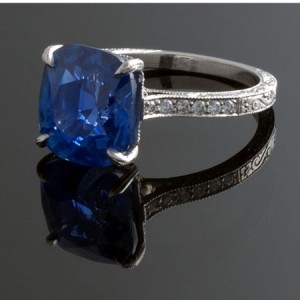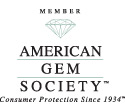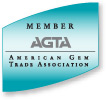The Impact of Enhancements on the Value of Gems
March 3rd, 2009 by James L. Sweaney, CGA, FGA. GGI attended a meeting last November of the Orange County GIA Alumni to hear Richard Drucker speak. His firm, Gemworld International, and the AGTA Gemological Testing Center co-sponsored the Inaugural World of Gems Conference, held Sept. 2008 in Chicago. In February, we finally received Gemworld’s publication of the proceedings.
Richard, publisher of the Gem Market News and The Gem Guide price list and appraisal software, is one of the most dependable sources of information about gems, the gem trade, and gemstone prices that we know of. We use his appraisal software and pricing information on a daily basis and find it to be consistently accurate and reflective of true market conditions.
The subject of Richard’s talk was the disclosure of gem treatments and how such treated gems are priced in the marketplace, along with an update of the latest gem news and issues. He reinforced what we already know, that heavily treated gems can never be considered top quality. Moderately enhanced gems are the general standard by which Gem Guide prices are set, but the level of enhancement considered moderate varies from gem to gem. Additionally, the impact of enhancements varies with size, with the effects generally accelerating with increase in size.
In the case of Ruby, the usual enhancements are heat and flux healing. Unenhanced rubies graded anywhere from good to extra fine generally sell for 100 to 200% more than moderately enhanced stones. The market makes a price distinction between Burma ruby from Mogok and Mong Hsu, especially for unheated material, and ruby from all other sources. With the U.S. embargo on the importation of Burma ruby, we can expect to see more material from these other sources.
A torrent of very cheap glass-filled ruby has flooded the marketplace, often selling for as little as a dollar per carat. Some is so heavily filled that gemologists will have to decide whether to call this material glass or ruby.
With Emerald, the traditional enhancements are the various filler materials – organic oils, epoxy type resins, etc. – used to penetrate and disguise the internal fissures and inclusions of the gemstone. The actual filler used makes little difference in the value of the stone – rather, it’s the amount of filler required to make the stone beautiful.
Unenhanced fine to extra fine emeralds sell for at least 50 to 100% more, while fine to extra fine goods with minor amounts of enhancing fillers bring up to 10 to 30% premiums in 1 to 5 ct. sizes. Dealers of Colombian stones generally ask for a premium of as much as 30 – 40% over similar stones from other sources.
For Sapphire, the presumption is that the stone has been heat-treated. Beryllium has been added to some heat treatments creating diffused un-natural colors. Unheated blue sapphires in good to extra fine qualities generally bring premiums ranging from 10 to 60%.
Fine and Extra Fine Kashmir sapphires are in a class by themselves because of their rarity—a comparison of four similar 3 ct. sapphires by Gem Guide showed a range of $2,500 to $3,800 per carat for 3 stones from Sri Lanka, Madagascar, and Burma respectively, while the Kashmir stone was priced at a whopping $28,000 per carat! About 4 years ago, we sold an extra fine six carat Kashmir for almost six figures – looks like our client has about doubled her money and has had the enjoyment of wearing her investment. Not a bad return should she choose to part with this fine collector stone!

Pearls are generally enhanced by dyeing or bleaching. The South Sea “Chocolate” Pearls that have been all the rage have been either heavily dyed or bleached, with dyed pearls outnumbering bleached ones 100 to 1. Prices for a 10 mm round “chocolate” pearls range from $100-150 per pearl for bleached, $30-65 for dyed. Most of the strong colored golden pearls on the market are dyed—these sell for about 30% of the price of natural color golden pearls. Prices for these treated pearls are expected to decline, as information about these treatments becomes general knowledge.
Gem Market News has issued a trade alert for synthetic red spinel. These are flux-grown stones that are extremely difficult to detect, having inclusions and properties that are very similar to natural material. Verneuil produced synthetic spinel has been around for years as a cheap substitute for birth stones and is very easy to detect. The obvious intent of this new material is to take deceptive advantage of the hot market for the new finds of extra fine natural red spinels. We’ll keep our eyes open for this one!
Because gems are found in all corners of the planet, and are brought to market through a supply chain of miner, cutter, dealer, jeweler, we in the industry rely on each other for information about our goods. In general, the track record is good— Our information sources like “Gems and Gemology” and the Gem Guide are excellent and the gem dealers who sell quality gems are very knowledgeable and usually quick to detect the “too good to be true” material.
Unfortunately, some sources for gems are notorious for deliberate misrepresentation or for not disclosing new treatments. The gem trade, a relatively small industry, doesn’t have enough resources to research and immediately detect all the new technologies and treatments. As in any group, it’s a constant battle for the good guys to keep up with the bad guys. As Richard said, “That’s the way it is.”
Most of us in the gem business are in it for the love of gems, not the money. There are a lot easier ways to make money. But the breath-taking beauty and magic of gems and the challenge of an ever-changing marketplace make the risks worth the rewards.
We at Mardon depend on the trust of our clients and work very hard to justify that trust. As members of the American Gem Society (http://www.americangemsociety.org/) and the American Gem Trade Association, we strive to educate ourselves about the gems we sell, and to do business only with reputable and knowledgeable dealers. Our policy regarding enhanced gems is as follows:
• We offer untreated gems whenever these gems meet our criteria for beauty and desirability.
• We offer gems that have been enhanced by normal and traditional trade practices, such as heat treatment of aquamarines, topazes, and numerous other gem species, and oil/resin enhancements of emerald.
• We always disclose fully any and all gem enhancements.
• We offer free educational materials and are happy to discuss in detail any and all gem enhancements with our clients. The following is an example of the type of information we provide as a matter of course, excerpted from the Gemstone Information Manual, Eight Edition. P. 104-105, available in total as a free download on the AGTA website.
ENHANCEMENT: Any traditional process other than cutting and polishing that improves the
appearance (color/clarity/phenomena), durability or availability of a gemstone.
A gemstone enhancement is considered permanent as long as the effect of the enhancement
does not change under normal wear, cutting, repair, cleaning or display conditions. If a gemstone
enhancement is not permanent, appropriate disclosure is required.
All natural gemstones can be divided into three basic categories:
1) Those which are not enhanced.
N The “N” symbol appears on the chart only for natural stones which are not currently known
to be enhanced (Alexandrite, Garnet, etc.). However, the “N” symbol can also be used for
other natural gemstones in the event that a gemstone has received no enhancement and the
seller will provide a guarantee that there has been none. That gemstone must be accompanied
by a commercial document, such as an invoice, memorandum and/or a laboratory report, to
support the fact that the gemstone is not enhanced.
2) Those which are normally enhanced.
E The “E” symbol indicates that the gemstone has undergone its traditional enhancement
process. The type of enhancement process covered by this symbol is indicated on the charts
on pages 107 through 116. For example: The “E” designation for Aquamarine means only
the enhancement that is described in the chart on page 107, i.e., thermal enhancement. In
the case of Emerald, the “E” designation refers only to the penetration of colorless oil, wax
and/or resins into ?ssures.
Since many enhancements are dif?cult or impractical to prove de?nitively, the approach taken
in this manual is, unless otherwise indicated, to assume that such traditional enhancement has
been done to that particular gemstone. This assumption has been made in order to protect
both the seller and the consumer.
The “E” symbol may be used for those gemstones and for those enhancements as prescribed
on the chart. However, if the speci?c method of enhancement is known, the seller should use
the speci?c enhancement code in place of the “E” symbol. (For example: “H” would be used
for an Aquamarine in place of “E” [see page 107]).
3) Those treatment processes not covered under the “N” or “E” symbols are addressed in a speci?c
manner as shown on pages 107 through 116.
For example, Ruby “F.” The surface cavities are ?lled with a foreign matter such as glass.
Within the industry, this gemstone must be labeled with the letter “F.” This information must
also be provided to the consuming public in writing using plain language. Abbreviations and
codes are not suf?cient.
NOTE: Multiple enhancement techniques are sometimes applied to the same material.
All treatments must be listed. Example: Diamond “LF” (Lasering and Filling).
SYMBOLS FOR SPECIFIC FORMS OF ENHANCEMENTS
B Bleaching: The use of heat, light and/or other agents to lighten or remove a gemstone’s color.
C Coating: The use of such surface enhancements as lacquering, enameling, inking, foiling or
sputtering of ?lms to improve appearance, provide color or add other special effects.
D Dyeing: The introduction of coloring matter into a gemstone to give it new color, intensify
present color or improve color uniformity.
F Filling: The ?lling of surface-breaking cavities or ?ssures with colorless glass, plastic, solidi?ed
borax or similar substances. This process may improve durability, appearance and/or add weight.
H Heating: The use of heat to effect desired alteration of color, clarity and/or phenomena.
If residue of foreign substances in open ?ssures is visible under properly illuminated 10X
magni?cation, H F should be used.
HP Heating and Pressure: The use of heat and pressure combined to effect desired alterations of
color, clarity and/or phenomena.
I Impregnation: The impregnation of a porous gemstone with a colorless agent (usually plastic)
to improve durability and appearance.
L Lasering: The use of a laser and chemicals to reach and alter inclusions in gemstones,
usually diamonds.
O Oiling/Resin Infusion: The ?lling of surface-breaking ?ssures with colorless oil, wax, resin or
other colorless substances, except glass or plastic, to improve the gemstone’s appearance.
R Irradiation: The use of neutrons, gamma rays or beta particles (high energy electrons) to alter
a gemstone’s color. The irradiation may be followed by a heating process.
U Diffusion: The use of chemicals in conjunction with high temperatures to produce ARTIFICIAL
color change and/or asterism-producing inclusions.
Note: It is a violation of the FTC Guides to fail to disclose diffusion on gemstones in
advertising, promotional literature or commercial documents. Suggested methods of
disclosure are:
“(Gemstone): chemically colored (Color) by diffusion.”
Example: “Sapphire: chemically colored blue by diffusion.”
If the color of the diffused gemstone does not permeate the entire stone, then the
following statement must also appear:
“Although the color induced in diffusion treated gemstones is permanent, it does not
permeate the entire gemstone; therefore, recutting or repolishing is not recommended.”
The above disclosure language must be printed in a type size and location so as to be conspicuous.
W Waxing/Oiling: The impregnation of a colorless wax, paraf?n or oil in porous opaque or
translucent gemstones to improve appearance.
Tags: Enhancement, Gem Treatments







